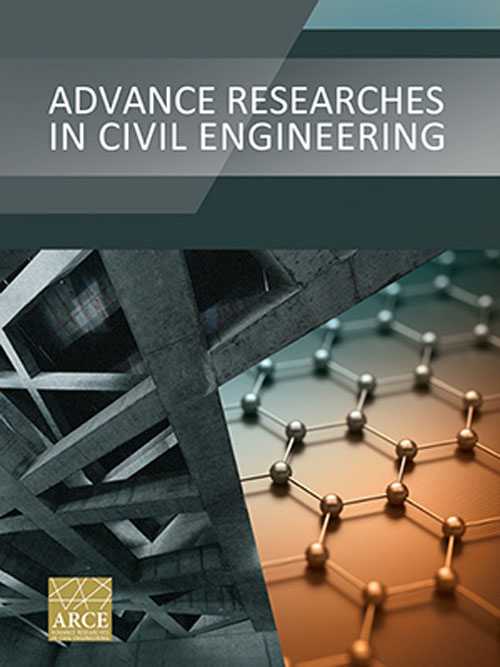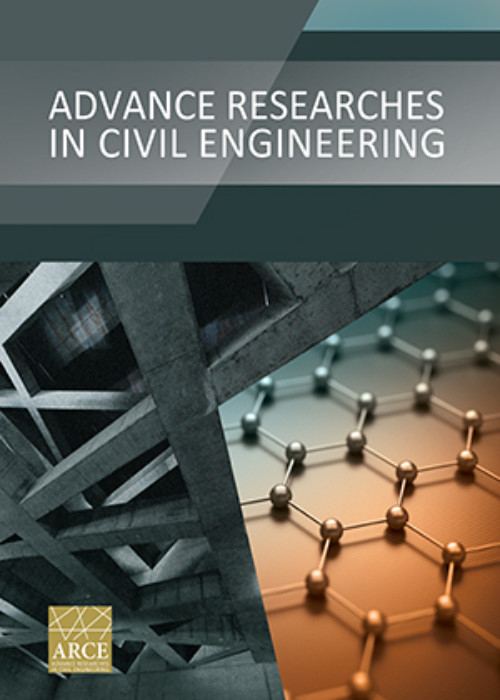فهرست مطالب

Advance Researches in Civil Engineering
Volume:1 Issue: 3, Summer 2019
- تاریخ انتشار: 1398/04/10
- تعداد عناوین: 6
-
Pages 1-18In recent years, with the increasing demand for modern and environmentally friendly materials, natural pozzolan s can be proved to be such a material and several researchers have focused their research efforts in using it as a partial substitute in the manufacture of concrete and mortar. This study concerns the fresh and hardened properties of self-compacted concrete (SCC) with natural zeolite (NZ). SCC mixtures were prepared by inclusion various amounts of NZ (0–20% by weight of cement) at different water/binder ratios. The fresh properties were investigated by slump flow, visual stability index, T50, V-funnel and L-box. The slump flow and compressive strength changes with hauling time were also considered. The hardened properties were tested for compressive strength, splitting tensile strength, ultrasonic pulse velocity (UPV), initial and final absorption. Results showed that with the inclusion of NZ, SCC can be successfully produced with satisfactory performance in flow ability, passing ability and viscosity. For all mixtures, flowability was lost with hauling time, although the rate of slump flow reduction was higher for mixes with higher amount of NZ. Regarding to hardened properties, the effect of NZ on the compressive and splitting tensile strength of SCC mixtures is generally related to its W/B ratio. Moreover, compressive strength enhancement was seen for mixes with slump flow higher than 550 mm at prolonged mixing time. The UPV measurement shows that the effect of NZ on the UPV values at a high compressive strength are negligible. Compared to control SCC, absorption characteristics of SCC containing NZ significantly decrease with increasing ages.Keywords: Self-Compacting Concrete, Zeolite, Durability, Hardened Properties
-
Pages 19-27Dynamic soil properties are very important topic in geotechnical earthquake engineering due to associated with dynamic loading. Probabilistic analysis of dynamic soil properties is as effective tools to evaluate uncertainty of soil parameters. In this paper, Monte Carlo Simulation (MCS) is used for reliability assessment of dynamic soil properties. For this purpose, a famous model is selected for predicting normalized shear modulus reduction and damping ratio curves. The selected stochastic parameters are internal friction angle, dry and saturated unit weight of soil which is modeled using normal probability distribution functions. To assess the reliability of dynamic soil parameters a computer model is developed for generating input parameter uncertainties. The results show that the shear modulus and damping ratio have more uncertainty for middle range of shear strain. The sensitivity analysis’s results show that saturated unit weight is the most effective parameter in shear modulus and damping ratio.Keywords: Damping Ratio, Shear Modulus, Monte Carlo simulation, Reliability assessment
-
Pages 28-35Indoor air quality is inevitably linked to ambient air quality. What controls ambient air quality also affects indoor air quality. The desert belts and their respective dust plumes on a global basis regulate ambient air quality. Each desert has its own exclusive extension zone and during the period of cyclonic depressions millions of tons of dust is injected into the atmosphere. These dust particles having 10- micron size or less can traverse long distances and are composed of clay minerals and embedded bacteria fungus and viruses. It has been shown that when inhaled it may adversely affect the respiratory system as well as triggering genes that are responsible from the production of specific proteins that results with migraine attacks. Basing on this work we have developed simple water based air purifier system that can effectively removes 90 % of particles in an hour and ultimate purification is reached within 120 minutes in one cubic meter experimental chamber. Of course, increase in air flux will inevitably shorten the time necessary for ultimate purification for a given environment. The air purifying system consists of an aquarium pump hose and air stone and simple 5 l water bottle. The basic principle behind the purification system based on the fact that during the rise of air bubble the air bubbles increases the surface area that is in contact with water and friction with water creates a vortex further assisting the transfer of any particles and bacteria fungus and virus to water phase. With this simple purification system the adverse effect of dust particles can effectively be removed from indoor environment. Renewing the water is the only thing required for the continuation of effective purification. The water is not wasted and can be used to irrigate the flowers lawns etc. Such systems also offer an ideal low cost pre-cleaning filtering that can be used to extent the operational life of expensive filtering systems.Keywords: Air Quality, Bacteria, Dust, water filtration
-
Pages 36-48In this paper the water cycle algorithm (WCA) is utilized for sizing optimization of space trusses. Finding the optimum design of 3-D structures is a difficult task as the great number of design variables and design constraints are present in optimization of these type of structures. The efficiency of the WCA are demonstrated for truss structures subject to multiple loading conditions and constraints on member stresses and nodal displacement. Numerical results are compared with those reported in the literature where the obtained statistical results demonstrate the efficiency and robustness of WCA where it provided faster convergence rate as well as it found better global optimum solution compared to other metaheuristic algorithms.Keywords: Water Cycle Algorithm, Weight Optimization, Space trusses, Global optimum
-
Pages 49-57Autoregressive integrated moving average (ARIMA) models are appropriate for the annual streamflows (annual peak and maximum and also mean discharges) of the Karkheh River at Jelogir Majin station of Karkheh river basin in Khuzestan province in western Iran, through the Box- Jenkins time series modelling approach. In this research among the suggested models interpreted from ACF and PACF, ARIMA(4,1,1) for all annual streamflows satisfied all tests and showed the best performance. The model forecasted streamflow for ten leading years showed the ability of the model to forecast statistical properties of the streamflow in short time in future. The SAS and SPSS softwares were used to implement of the models.Keywords: Hydrologic Time Series, Box-Jenkins Approach, Arima Model, Karkheh river
-
Pages 58-71Semi active devices can be used to control the responses of a continuous bridge during earthquake excitation. They are capable of offering the adaptability of active devices and stability and reliability of passive devices. This study proposes two semi-active control method protection of bridge using variable stiffness and damping systems and MR dampers. The first method is variable stiffness and damping with eight different (on-off) control schemes which is optimized with genetic algorithm. Genetic algorithm is used to define the parameters of this method. In the second method, an intelligent controller using fuzzy control of MR damper is developed. In particular, a fuzzy logic controller is designed to determine the command voltage of MR dampers. In order to evaluate the effectiveness of the proposed method, the performances of the proposed controllers are compared in numerical study. Results reveal that the developed controllers can effectively control both displacement and acceleration responses of the continuous bridge.Keywords: Semi-active devices, MR damper, Variable stiffness, Variable damping, GA algorithm, Fuzzy logic control


